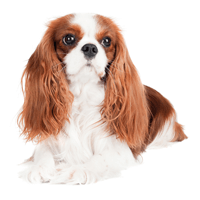
Life span: 9 – 14 years
Occasionally seen: Retinal dysplasia
Major concerns: MVI, CHD
Suggested tests: Cardiac, hip, knee, eye
Avg Size of male: Height: 12 – 13 inches, Weight: 13 – 18 pounds
Avg Size of Female: Height: 12 – 13 inches, Weight: 13 – 18 pounds
Minor concerns: Patellar luxation, entropion
Note: Cavaliers should not be bred until the age of 5 years, and only after being checked at that age for MVD
Brief History on Cavalier King Charles Spaniel Origin
According to some stories, King Charles II was very interested in this breed. Because of his close affiliation with them, this dog originally became known as the “King Charles Spaniel.” A favorite amongst the wealthier community, the King Charles Spaniel was used as a house dog for many years. Although it is an interesting fact that over time, a breed of dog with a shorter nose became even more popular. In fact, the few dogs still in existence that had the longer nose were considered to be inferior. Until one day a wealthy American named Roswell Eldridge, came to England to offer a substantial amount of prize money (25 pounds) for the best “pointed-nosed”, or in other words, longer nosed spaniels. He was set on purchasing two dogs of with this characteristic, because they most resembled the first original style of the breed. This version of the Spaniel also featured a flatter skull, and a spot in the center of the forehead commonly known as the “Kiss of Buddha.” The shorter nosed dog eventually lost it’s popularity and reputation among the people, while the pointed-nose took it’s place and became one of the most popular breeds in England. This pointed-nose dog did not find the same popularity in America. It was in 1952 that this first of this breed was known to the United States, but it wasn’t until 1996 that the AKC recognized the Cavalier King Charles Spaniel.
Cavalier King Charles Spaniel Breed Appearance
The Cavalier is regal and elegant at first impressions, and is normally just slightly longer than it is tall. The front legs are straight, and its compact feet have well-cushioned pads. The well-proportioned head of this breed features large, round eyes that offer a devoted, tender expression. The eyes are usually a warm, medium to dark brown color. The lengthy ears usually feature quite a bit of soft, curly or wavy hair and they sit high on the head. The muzzle is tapered slightly, and usually features teeth that meet in a scissor bite. The tail is well proportioned to the body, and described as being carried low to the ground. While the gait of the Cavalier is independent and sophisticated. The coat is silky and moderately long, usually with a slight wave or curl pattern in some areas. Feathering can normally be found on the ears, chest, legs, feet, and tail. The coat comes in a variety of colors including Blenheim, Ruby, Tricolor, and Black & Tan.
Cavalier King Charles Spaniel Breed Temperament
The Cavalier King Charles Spaniel is known to be a pleasant, tenderhearted, and playful breed. Making for an devoted dog that loves to spend time with it’s family. This breed can be an exceptional companion for the elderly or disabled. This breed thrives on human companionship, and needs attention to be happy. The Cavalier does best with older, more mindful children. They normally get along well with other dogs and non-canine pets. It is all around an intelligent breed that responds well to gentle and positive training sessions. Leaving the dog alone all day is not ideal, since this breed does best when it is around it’s family members. Leaving it home for long periods of time could result in anxiety related behavioral issues.
Cavalier King Charles Spaniel Breed Maintenance
This breed’s coat does require some time and care. It should be brushed every other day with a firm bristle brush. Bathing or the use of dry shampoo should only be done when necessary, to avoid stripping the skin of natural and essential oils. Pay close attention to the feathering on the ears while brushing down your Cavalier, as it can easily get tangled or mat. Also, be sure to clean and check the ears regularly. When you do bathe them, be sure that the dog is completely dried off after cleaning them. Watch the eyes for any signs of infection and if you notice that they are looking irritated, make an appointment with your vet and they will address it. Even though the Cavalier King Charles is an indoor breed who adapts relatively well to an apartment dwelling, a small yard is ideal to easily meet it’s daily exercise requirements. Please be aware that this breed doesn’t do well in very warm conditions, adjust indoor temperatures accordingly in the hotter months of the year to keep them happy and comfortable.
 Toledo, United States.
Toledo, United States.
